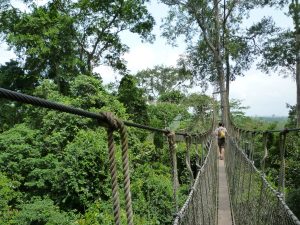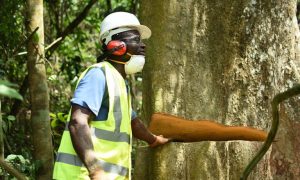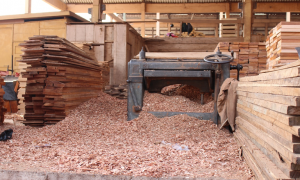Illegal logging driving Afromosia to extinction in Ghana
Pericopsis elata is a valuable timber species occurring in moist semi-deciduous forests with annual rainfall of 1250-1500 mm. The tree is a leguminous species of the fabaceae family, popularly known under its trade name as Afromosia. The species of the close, Guinean-Congolese forest type. Its natural range is discontinued, with several isolated sub-stands in Ghana, Côte d’Ivoire, South-eastern Cameroon, Northern Congo, the North-eastern portion of the Democratic Republic of Congo, and the South-Western portion of the Central African Republic (CAR).
The wood is highly valued on the international market, mainly for furniture and as decorative veneer, but also for interior and exterior joinery, stairs, flooring and boat building. It is considered a substitute for teak. It is also suitable for heavy and light construction such as railway sleepers, vehicle bodies, interior trim, handles, ladders, agricultural implements, sporting goods, musical instruments, toys, novelties, boxes, crates, carvings, turnery and draining boards. In traditional medicine in the Congo, the pulped bark is rubbed into scarifications as an anodyne
The species (P. elata) is a victim of over-exploitation and consumption mainly for its precious wood. Ghana is one of the countries where this species occurred in commercial quantities and has been heavily logged because of its highly-valued timber. Exportation of P. elata timber from Ghana to England started as far back in 1948 (Bourland et al., 2012: Howland, 1979). Currently, it is one of the few commercial timber species that has been listed under Appendix II of the Convention on International Trade in Endangered Species of Wild Fauna and Flora (CITES). This means, trading in the species is not permitted without special authorization by the relevant authorities of the exporting country. This authorization is by way of CITES certificate issued by the CITES Management Authority upon application by the exporter. In the case of Ghana, the Wildlife Division of the FC is the responsible authority for issuing CITES certificate.
In Ghana, the species occurs in specific forest types. It is distributed in forest reserves within the moist semi deciduous vegetation zone in the Western and Brong Ahafo regions of Ghana, particularly in the Juabeso, Goaso and Dormaa- Ahenkro forest districts
Currently, the species is under heavy stress from logging and general degradation of it habitat forests. As a strategy for reducing such pressure on the species from logging, the Forestry Commission of Ghana has by administrative process classified it as a restricted species for harvesting since its enlistment under CITES Appendix II in 1992. Nevertheless, besides this classification, nothing more has been done to protect the species.
In a bid to help better conserve the species, Nature and Development Foundation (NDF) with support from the International Tropical Timber Organization (ITTO) has made available through studies, current data on the distribution, conservation, market and trade status of the species in Ghana. The studies revealed that, tree stock densities are quite low ranging between 0.013 -0.526 and the diameter class of 10-29 cm contributes the least (0.05 %) to the volume of wood in the reserves studied.Natural regeneration in the species was also found to be unreliable as recruitment to the exploitable intermediate and larger size classes are often inadequate
There are fears it is gradually towing the line of extinction because, even though in a bid to protect it, the Forest Services Division (FSD) in the past decade has placed an embargo on harvesting the species for timber or any sort, a walk through some timber markets and sawmills in Accra and Dormaa Ahenkro in the Brong Ahafo Region of Ghana showed a continuous sale of the wood species in the part of the country without any license.
Currently, the total wood harvest can reduce to a third when Pericopsis elata is harvested using the felling limit of 110 cm (DBH). It is also clear that in maintaining the legal felling diameter (110 cm DBH) the existing volume of wood at the estimated harvest level will only last for three years.
The resource life (the number of years that a species can continue to be commercially utilized at the current rate of extraction) of the species was also found to be zero. The scenario at the moment is not different from the situation some three decades ago which suggests that the species is still under threat and may not be sustainably harvested.
In conclusion, the project has contributed to addressing the information gap in the sustainable management of P. elata in Ghana. Public awareness and interest in the species have also been raised as a component of the project produced 8-10 minute video documentary that is aiding advocacy and public education on impact of unsustainable logging and trade in the species. This has in turn placed pressure on authorities to develop policy for saving and regenerating the species. Precisely, the government of Ghana has started some plantations and enrichment planting of the species within its ranges
AUTHORS
Ms. Margaret Appiah
Projects Officer at NDF
Debora Baiden Bediako
Project Intern at NDF


